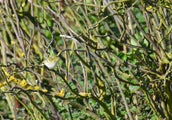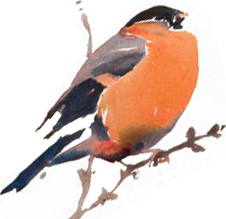Some of the birds that are most special to me now are the ones that really captured my imagination when I was a child. As a young and mad keen birder, I wasn’t too concerned about travelling to the farthest corners of Europe to see vultures, pelicans and bee-eaters (my world view was constrained by the maps in the field guides I looked at); I was more interested in what rarer birds I might see on my own doorstep. Not the mega rarities but the uncommon species for which reports would trickle through each year – things like Sooty Shearwater, Lapland Bunting, and the rarer skuas. Top of my list, however, was the Yellow-browed Warbler. This tiny species, all stripes, didn’t even have a map in most field guides, which made it feel extraordinarily exotic to me. Of course, I remember my first one, seen one September day on Hartlepool headland, shortly after seeing my first Red-breasted Flycatcher. Surrounded by wax jackets and deep voices, I felt like I’d suddenly grown up and stepped into a world of big-league birders. I was nine years old.
This was over thirty years ago and a lot has changed since then; this warbler has always been one of our more numerous rarities, being dropped from the list of species considered by the British Birds Rarities Committee way back in 1963 (along with species such as Mediterranean Gull and Pectoral Sandpiper). More recently, and quite suddenly, it has become even more common. Within the last ten years, we have started to see concentrated large arrivals of the species in the UK, with Scotland, and the northern isles in particular, contributing the majority of records. This surge has even seen it lost from the pages of the annual British Birds ‘Scarce Birds Report’, meaning that national numbers will no longer be published. With the three years running up to that decision seeing numbers totalling 2,843 (2015), 4,500 (2016) and 1,950 (2017) – three of the four highest ever annual totals – it’s easy to see why that decision was made. These birds tend to arrive over a couple of waves per autumn, and at times, Yellow-browed Warbler is almost certainly the most numerous warbler species on Scottish east coasts, and the northern isles.

How times have changed. On more than one occasion, my local patch of Girdle Ness, Aberdeen, has hosted over ten birds. This would have raised many an eyebrow 15 years ago, but now it is becoming the norm. Yellow-browed Warblers breed in Siberian Taiga forests and have traditionally wintered in south-east Asia. However, current thinking is that the recent increase in records is due to pioneering birds travelling westward to winter in the mild conditions offered in western Europe. Those that successfully return to breeding grounds and raise the following years’ young pass this new route on, resulting in yet more and more arrivals in this part of the world the following autumn.
In spite of the increase in numbers, these remarkable journeys, and the arrival of these charismatic birds on winds laden with eastern promise, has meant that for most birders, the charm is not lost. On October 2nd 2016, a group of us conservatively estimated 86 Yellow-browed Warblers on Sanday, Orkney – comfortably the most common migrant that day – yet each bird we saw captivated each one of us. Hopefully an excerpt of my diary from the day captures this.
As I headed down towards the Little Sea, the WhatsApp group that we’d set up to keep everyone in the team in the loop started to kick off. People were reporting multiple Yellow-browed Warblers from multiple locations - and apart from the bird in Lady earlier on, I hadn't seen a single one! The cemetery at the Little Sea was devoid, and the first garden at Ladybank was similarly quiet. The next garden, however, always a favourite of mine, delivered the goods with five Yellow-browed Warblers! The floodgates had opened, with yellow-brows noted from plenty of other locations as I made my way back towards Lady, including seven at the school and five in the village itself. I managed a total of 28 of these little stripey wonders during the morning, which completely eclipsed the handful of Redwing and Chiffchaff that had also arrived, and even the Jackdaw that flew over the school - an uncommon bird here and only the team’s second record for the island.
Over lunch, we discussed the numbers of yellow-brows that everyone else had seen, and it was clear that we were going to come up with a huge day total….
…On returning to the house later on, we did the evening log over a drink and came up with a conservative estimate of 86 Yellow-browed Warblers on the island. It really had been all about these little gems…

Late September and early October is peak time for the arrival of ‘yellow-brows’ into Scotland. As I write this (on September 21st), just a handful of birds have arrived. This means that the landslide is probably just around the corner, and may well have happened by the time you read this! We can’t say when it will happen but we can say that when it does, it’s going to be an awful lot of fun for those who can get to experience it. Stumbling into a little group of these now common migrants, as they reach out to one another through the Sycamores with their distinctive ‘tsooweet’ calls, is still one of birding’s big thrills.
Mark Lewis
SOC Birding and Science Officer
Photos © Mark Lewis




